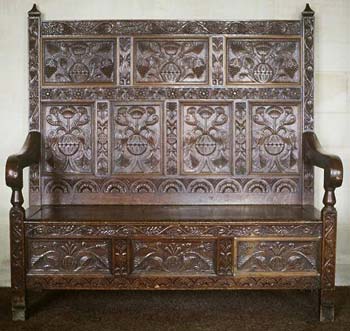
  Contact DetailsSchool of Art |
Welsh Folk CraftThe interest in Welsh folk craft emerged from H. J. Fleure’s broader scheme to demonstrate ‘a sketch of human workmanship in periods and regions’ around the world. Significantly, the collection developed at a time of growing awareness of the importance of local craft traditions in Wales. In 1927, some years after the University, the National Museum of Wales began its ‘Welsh Byegones’ collection under the direction of Iorwerth Peate who collaborated with Fleure on several publications on anthropology. As there were so few local craftsmen practising by the 1930s the curators worked quickly to acquire and document artefacts that were fast disappearing from the Welsh way of life. As the area of research developed its nomenclature changed from ‘Byegones’ to ‘National Folk Art’ reflecting the seriousness of their investigation of folk craft and industries. The collection formed at Aberystwyth, however, was more than a celebration of the material culture of country communities. It also stood for the ‘dignity of craftsmanship’, fitness to purpose and beauty of form integral to the ideology of the Arts and Crafts Movement. Oak Settle, late 19th century Dan Jones was responsible for the formation of the Welsh Folk Craft collection. He purchased from antique shops and salerooms in Aberystwyth and around Wales, assisted by staff, friends and former students of the University who gave or procured exhibits for the Gallery. Appeals were also made to students to search their homes for unwanted ‘byegones’ to supplement the Collection. The work of the blacksmith was represented by rush light holders, candlesticks, sugar and tobacco cutters, nut crackers, fire irons and dairy utensils; the wood turner by simple carved or turned domestic and dairy utensils - plates, bowls, rolling pins and ladles; and the woollen industry by a spinning wheel and weavers’ fly pins. The Collection surveying the history of rural crafts in Wales stressed the important contribution which native craftsmen and women have made not only to their communities but to Welsh culture in general. In their work both form and decoration were necessarily subservient to function, yet in these ‘simple and unaffected’ crafts beauty and function were seen to be at one. It was to ‘such objects, more perhaps than any others’, wrote Dan Jones, ‘that we look for the inspiration of a proper spirit of craftsmanship.’ Dan Jones | H.J.Fleure  Welsh Folk Craft - Ceramics | Welsh Folk Craft - Furniture | Welsh Folk Craft - Love Spoons Welsh Folk Craft - Ceramics | Welsh Folk Craft - Furniture | Welsh Folk Craft - Love Spoons Artist Collections | Art Pottery | Baskets | Bequests | Calligraphy | Ceramic Archive | Ceramic Figures | Ceramics | Classical Subjects in the 1920s | Collecting Contemporary Ceramics | Collecting Contemporary Prints | Colour Woodcuts | Drawings | Early British Studio Pottery | Gifts | Glass | The Great and the Good | Gulbenkian Collection | Highlights of the Collection | Illustrators of the 1860s | Lithography in the 1920s | Loans | Musical Instruments | Overview | Paintings | Photographs | Portraiture in the 1920s | Prints | Prints of the 1920s and 1930s | Private Press Books | Publications | The Historic and Retrospective Collection of Ceramics and Bronzes | Search | Special Collections | Watercolours | Weaponry | World Craft collections Artist Collections | Art Pottery | Baskets | Bequests | Calligraphy | Ceramic Archive | Ceramic Figures | Ceramics | Classical Subjects in the 1920s | Collecting Contemporary Ceramics | Collecting Contemporary Prints | Colour Woodcuts | Drawings | Early British Studio Pottery | Gifts | Glass | The Great and the Good | Gulbenkian Collection | Highlights of the Collection | Illustrators of the 1860s | Lithography in the 1920s | Loans | Musical Instruments | Overview | Paintings | Photographs | Portraiture in the 1920s | Prints | Prints of the 1920s and 1930s | Private Press Books | Publications | The Historic and Retrospective Collection of Ceramics and Bronzes | Search | Special Collections | Watercolours | Weaponry | World Craft collections Collections Collections |